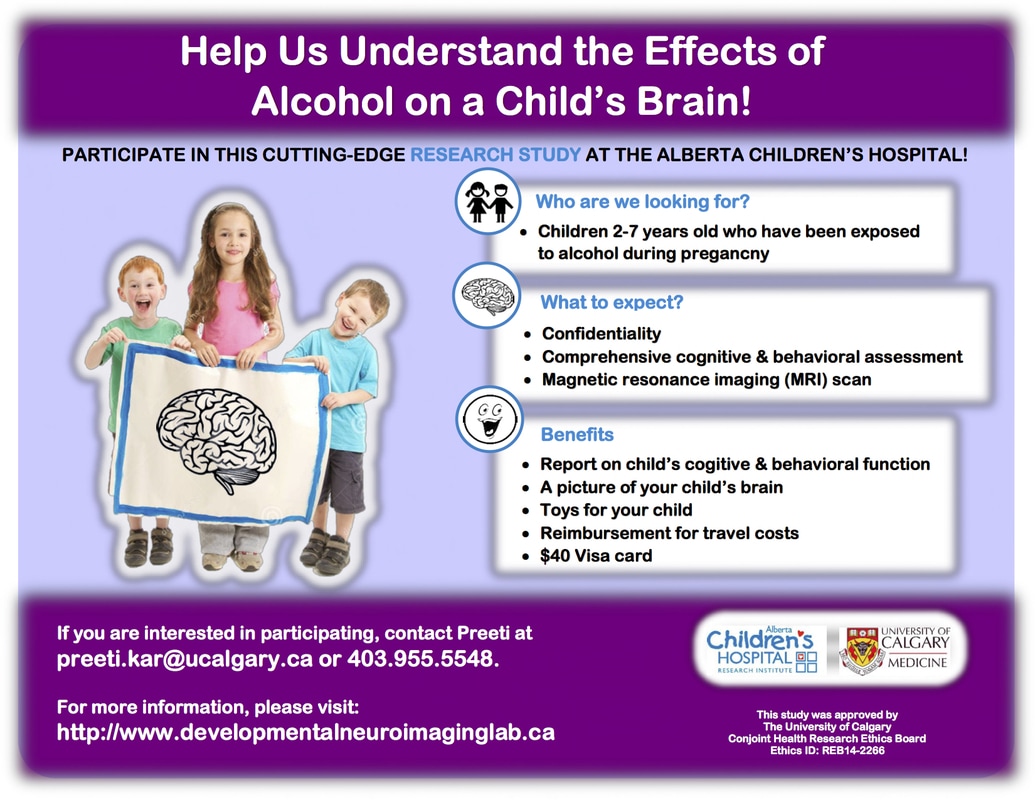Participate Prenatal Alcohol Exposure Study
Brain development occurs quickly in young children, and continues throughout childhood and adolescence. Prenatal alcohol exposure can affect brain structure and cause altered brain development in children. It is important to understand how brain development is altered with prenatal alcohol exposure, in order to develop effective screening tools and treatment options. Magnetic resonance imaging (MRI) can provide valuable information about brain structure and function. The purpose of this study is to examine brain development in children using MRI. Both children with and without prenatal alcohol exposure are included in this study.
Jump to Section
Information Criteria Participation Continued Participation Follow-Up
Your child must meet the following criteria in order to participate:
He or she must be
- Aged 2-8 years (first MRI scan to happen before 7th birthday)
- Have confirmed/documented prenatal exposure to alcohol
- Able to speak/understand English
- Able to lie still for approximately 20 minutes (while watching a movie)
- Able to wear ear plugs or headphones
He or she must not
- Have been diagnosed with a neurological or neurodevelopment disorder including autism, cerebral palsy, major intellectual disability, epilepsy; major medical illnesses, congenital abnormalities; genetic disorders associated with motor or cognitive disabilities. ADHD, learning disabilities and language delay are OK.
- Have had a major head trauma
- Have been born premature (<34 weeks) or experienced fetal distress.
In addition, for safety reasons, we will not be able to include children who
- Have certain metal implants or metal dental devices (check with us regarding eligibility)
- Are severely claustrophobic
What participation involves:
1st Visit: Training ( ~1-2 hours)
- Your child will undergo training for the MRI scan to become familiar with the MRI environment
- They will practice lying still in an MRI simulator
- You will be given training and practice materials to take home
- Your child may be given a cognitive and behavioural assessment (~30-90 minutes)
- You may be asked to fill out some forms about your child’s behavior
- Passes for visitor parking will be provided and childcare services may be booked in advance through Emily’s Backyard.
Practice and training (at home)
- You will be asked to talk with your child about the MRI scan at home and to familiarize your child with some of the equipment (i.e., ear plugs)
- You will be asked to have your child practice lying still while listening to the MRI noises
2nd Visit: Brain Imaging Scan (~1-2 hours)
- Your child will undergo an MRI scan at the Alberta Children’s Hospital
- Your child will have to lie still during the MRI scan
- The brain scan itself will last 20-40 minutes
- If your child did not attend a training visit, he/she may be given a cognitive assessment
- (~30-90 minutes)
- If you didn’t attend the training visit, you may be asked to fill out some forms about your child’s behavior and language development)
- Passes for visitor parking will be provided and Emily’s Backyard childcare services may be booked in advance.
What continued participation involves:
- Four follow-up language questionnaires: you will complete one questionnaire every 6 months. You may complete these questionnaires in person, by email, or over the phone with a member of the research team. Each questionnaire takes approximately 20 minutes.
- Four follow-up scanning visits: your child will come to the Alberta Children’s Hospital for four follow-up scanning visits, during which they will be asked to undergo a brain scan and be given a brief language assessment (approximately 20 minutes). The scan itself will last between 20-40 minutes. You will also be asked to complete a language questionnaire at each scanning visit (in addition to the four other questionnaires).
Why follow-up sessions are important:
By completing a series of brain scans, your child makes it possible for our research to observe changes in brain structure over time. Often, changes over time are better indicators of future success than measures at any one particular time point. We hope to use longitudinal data collected over a series of visits to define a trajectory of structural brain maturation from 2-8 years, and investigate how that is related to changes in learning and behaviour.